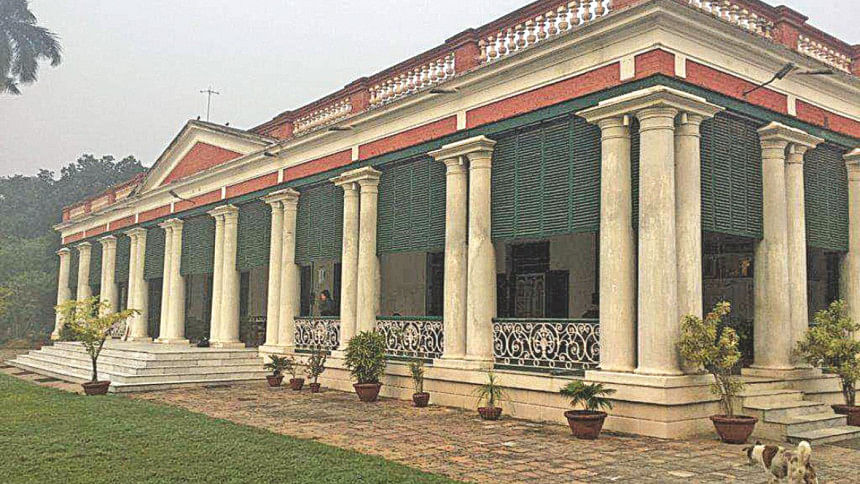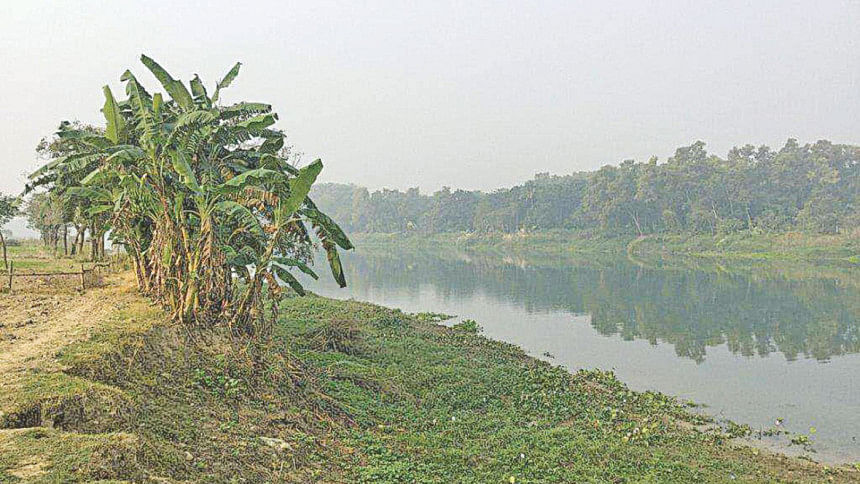ARCADIA ON THE JALANGI

(Concluding part)
Impinging Realities
It was not all utopian: Jones expected his researches, like his law codes, to have practical benefits. While enjoying his Arcadia, he was aware not everyone was living in a golden age. For all the endowments conferred by the Rajbari, the countryside had more than its fair share of not only pandits but of a corresponding religious manifestation, satis.
Only days before his death, in April 1794, Jones was trying to establish the nature of the Vedic sanction for sati: his wife's behaviour following his untimely death was exemplary of a more modern response, equally courageous: she burned to make his work public and sacrificed herself only on an editorial pyre.
Krishnanagar (the name often written as spoken, Kissen- or Kishna-ghur) also had more than its fair share of tigers and dacoits. A tiger-cub, as we have seen, was raised within the gates of the Joneses' estate. As for dacoity, some of it at least stemmed from the remorseless way drought, cyclones, bad harvests and famine drove the landless (and sometimes landed) poor into theft and criminality.
We see Jones employing local people in his researches and, a pittance as it would be, we can be sure none went away empty-handed. He not only gave more than his share towards famine relief (in 1788) but spent more than his own pocket would allow to support those pandits and maulvis with whom he worked unless and until he could enlist Government support for them.
In the mere decade he was in Bengal, he was fair, scrupulous and generous. All his literary work was published at his own expense and any profits given for the relief of insolvent debtors. The Joneses lived well but modestly, transmitting just so much money to England as would permit them to retire and live modestly there on an estate similar to that on the Jalangi.
Jones loathed the state of politics in England, he wanted to be independent of politicians and he declared that, if they could not live independently in England, they would live in exile on the Jalangi. They might have done that anyway but for Anna Maria's ill-health.
It is easy to mock a Briton in a well-paid job there for referring to Bengal as "the paradise of regions" but how many others of his countrymen have either then or now expressed a similar delight in the place or, for that matter, engaged with such energy and intellect in learning about the many manifestations of its culture from its people?
While Anna Maria would bravely strive to compile the good edition of his works her husband believed was the best monument to a man of letters, an immediate expression of the loss at Jones's death was seen in the unrestrained tears shed by the maulvis, both Shia and Sunni, and pandits, Vaishnav and Saivite alike, with whom he had worked.
One of those pandits, SarvoruSarma Trivedi, expressed a common feeling in lines that might equally have graced a Persian or a Sanskrit poem and were copied up by the English poet Coleridge: "To you there are many like me; yet to me there is none like you, but yourself; there are numerous groves of night flowers; yet the night flower sees nothing of the moon, but the moon".

Heritage Postscript
The matter of Sir William Jones should properly be left on that note but what if a contemporary, if less imaginative, traveller on the heritage trail in Bengal asks exactly where it was on the Jalangi the moon shone on Anna Maria as she moved among the flora and fauna of their retreat?
We know the potters of Ghurni, give or take some slithering away of the serpentine river, are where they were in the time of the Joneses. But where was it the Joneses lived out their pastoral myth and from which the world first came to know of Sakuntala?
Jones's letters do provide a few clues. Most crucially he tells Spencer to look at James Rennell's map of the Ganges Delta, one of four in that particular 1781 edition that includes much cartographical information about the district as it was in those days.
The left hand side of Rennell's map is bounded by Nadiya and the Hooghly river and framed by a line giving the latitude readings. Evidently because where he is living is so close to the edge of the map, this co-ordinate catches Jones's eye: he writes quite specifically to Spencer: "On the left hand, in lat. 23˚ 25́now sits your friend on a beautiful dry plain near Crishna-nagar… on the banks of a charming serpentine river…". There is no longitude reading on that part of the map to catch Jones's eye and so he does not give it.
Rennell's map indicates that the Jalangi had a lot more water in it then anda lot more islands, the great loop in it to the north between Krishnanagar and its mouth opposite Nadiya being marked by two channels with an island in the middle and swamp (not dry plain) immediately below it.
Since all Jones's contact is with Krishnanagar and Nadiya, it is most unlikely his estate would have been on the right Kasimbazar Island bank of the river or, for that matter, upstream beyond the colony of potters. Moreover, though making use of the river, he would also have wanted to be able to avail himself of the tree-lined road running between Krishnanagar and the ferry crossing to Nadiya. Therefore, the estate would have been on the left bank.
The Joneses' bangla was essentially a place of quiet retirement sometimes said by Jones to be "near" Krishnanagar and sometimes "close to" the celebrated college or university of Brahmans at Nadiya. There are less than ten miles by road (and ferry) between the two towns.
Because the Jalangi makes a great loop between the towns, though with some shift in its course since Rennell drew his map, we can fairly surely put our finger on the two places at lat. 23˚ 25́where the Joneses' estate was most likely to have been situated. One is near Krishnanagar where the river flows northward after leaving the town behind; the other is close to Nadiya (though still with a Krishnanagar address) where the river, having looped south again, turns westward to its confluence with the Bhagirathi.
At the latter point there is an estate at lat. 23˚ 25́ that has been an estate for at least the past 200 years, being occupied by the Pal Chaudhuri family for three generations and before that by three generations of the Savi family of indigo planters. This is at Maheshgunj (on or about the site of the Sabajnagarmarked on Rennell's map of the Hoogly river) and its extensive mango orchard surrounds a neo-Classical mansion thought to have been built early in the 19th century.
Possibly John Angelo Savi, one time doctor to Tipu Sultan, whose prolific family managed or owned many indigo estates in Bengal, built it when he spread out there from Kulberia in or about 1820, though it is just possible somebody else had built it earlier. Whoever built it, they could well have chosen the estate for its location on a prime pre-existing site, pulling down an old mud and thatch bangla already thereto make way for a more imposing building designed to last a couple of hundred years.
There is no sign of any such estate at the alternative latitude position on the river some four miles closer to Krishnanagar, just south and short of the hospital outpost of Shaktinagar. That means nothing: history and geography are full of tricks that lead us a merry dance and Bengal's rivers, which have hitherto led the choric dance hereabouts, quickly wash away the habitations of mud and figures of clay, even the goddess, they perennially throw up on their ever-changing banks.
[Sources: The Letters of Sir William Jones, vol. II, ed. Garland Cannon; James Rennell's Bengal Atlas; "The Banks of the Bhagirathi", Calcutta Review, vol. VI; Orientalist Jones, by Michael J. Franklin]
John Drew is a poet from Cambridge who also writes about cricket, most recently in the December 2016 issue of the ESPN Cricket Monthly. He was travelling in rural Bengal recently and on returning home started to look into the history of one small patch of it.

 For all latest news, follow The Daily Star's Google News channel.
For all latest news, follow The Daily Star's Google News channel. 



Comments